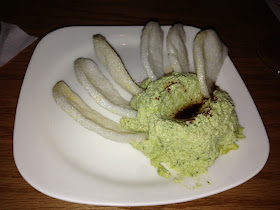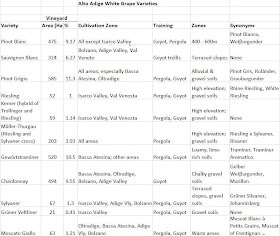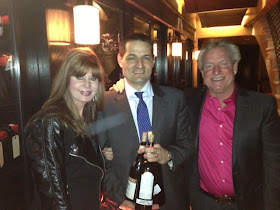Last Thursday, Henry (a friend; and the King of soft openings) attended the soft opening of Carmel Cafe and was so excited by what he saw that he texted my wife and told her that the place was a must-visit. Fast-forward to yesterday afternoon. I had just returned home from an unfulfilling round of golf and was settling in to complete the writeup of my Alto Adige wine tasting notes when my wife suggested (demanded?) that we go to dinner at this new place that Henry had mentioned. I didn't really feel like writing up my notes, and I was dispirited by my round of golf, so I jumped at this potential upliftment opportunity.
We arrived at the restaurant during a tropical downpour but when I pulled up, one of the staffers approached the car on the passenger side carrying an umbrella which he used to provide my wife dry passage to the restaurant door. Another staffer passed a secured umbrella to me through the open passenger door for me to use for my travel back from the parking lot. (The restaurant does not have a valet parking option at this time and I did not enquire as to whether this was in their future plans.).
When I entered the restaurant, I was greeted by a trio of hostesses standing directly opposite the entrance door and grouped around a small, low-slung, circular table upon which a wine box had been set. My wife had already been seated so one of the hostesses walked me back to our table. My first impressions, as I threaded my way back, were very favorable. The design and layout were esthetically pleasing with a large, well-lit, pleasingly decorated bar to the eastern end as the focal point and a "core" seating area directly across from the bar. This core was furnished with multiple-seat, high-top tables, standard tables, and orange-colored couches. The core was ringed by a walkway which separated it from more traditional booth-style seating. Wine racks were deployed at the southeastern corner of the restaurant and, just in front of them, a special-occasion seating area which could be separated from the larger dining room by blinds if the occasion warranted it.
When I got to my table I was welcomed by our server who had already begun to engage my wife on the unique elements of the restaurant. One of the cool aspects was the way in which they had integrated iPad technology into every aspect of operations. The hostesses used iPads to manage and allocate seats. Every food and drink item is listed on an iPad that is left at your table for the duration of your stay and you have the option of ordering intuitively using the tablet (orders go directly to the kitchen or bar and are brought directly to your table in fairly short order) or using the paper menu and the server to place your order. The iPad menu contains images of the of all the food items, thus adding a graphical aid that would require a bulky hard copy to provide similar context.
The server at our table was enthusiastic, well-trained, and very knowledgeable about the restaurant, its objectives, its offerings, and the technology (in a later conversation with the manager, he mentioned that they had been fortunate to recruit a team that had been open to the rigorous training regime and seemed to have absorbed it well.). I ordered two glasses of Zardetto Prosecco and was very pleased with the quality of the flutes when the order arrived. The wine list, by the way, is not a "fine-dining" list but is extensive and has quality representation from the major wine regions of the world. The focus is on California, however. The customer has the option of purchasing 3-, 6-, or 9-oz pours, or the entire bottle if that is their druthers. Sparkling wines can be bought either by the bottle or as 6-oz pours.
According to our server, the food can be best described as Modern Mediterranean with an old and new world mixture. I wasn't sure what that meant but figured I would find out sooner or later. The menu is extensive with flatbreads, salads, soups, and shareable plates fronting the main courses. A pleasing characteristic of the restaurant is that the main courses can be ordered as small or large plates thus giving the customer the opportunity of eating tapas-style if he/she so desires. Another pleasing characteristic is its support of customer dietary restrictions. There is a vegan menu, a vegetarian menu, a garlic-allergy menu, and a gluten-free menu.
We started our meal with the Chickpea Fries, from the Signature Shareables portion of the menu, and a cup of the Tuscan Vegetable soup. We ordered using the iPad and the order was fulfilled pronto. The Chickpea Fries came as stacked, oblong blocks on a long plate framed by two small bowls containing tomato jam and curry aioli dipping sauces. The Tuscan Vegetable soup contained green peas, canneloni beans, carrot cubes, and Chard in a wonderfully flavored broth. The Chickpea Fries were an explosion of flavor in the mouth with great texture and comfortable spiciness and handled both sauces equally well.
We followed up the first course with an order of Edamame Hummus. This is made with crushed Edamame and Mediterranean seasonings and is presented with a topping of chili sumac oil and ringed by an array of Puffed Vegetable Crackers. This was so good that we had a second order.
For the main course I had the Seared Lamb Lollipops with Tzatzki sauce and my wife had the Moroccan Lemon Chicken (chicken breast, pine nuts, saffron, olives, lemon, vegetable cous cous) and a side order of Chard. The lamb was juicy and flavorful. The ingredients in the Moroccan Chicken worked well together; oh the complexity of flavors in the mouth.
To cap the experience, we used the iPad to call our bill up, swiped our card in the place provided, and did a self-checkout. You have the option of having the receipt emailed to you or having a hardcopy printed in the restaurant and brought to your table.
This restaurant is positioned somewhere between Luma and Hillstones but with very reasonable pricing. I would recommend wholeheartedly.
©Wine -- Mise en abyme










































